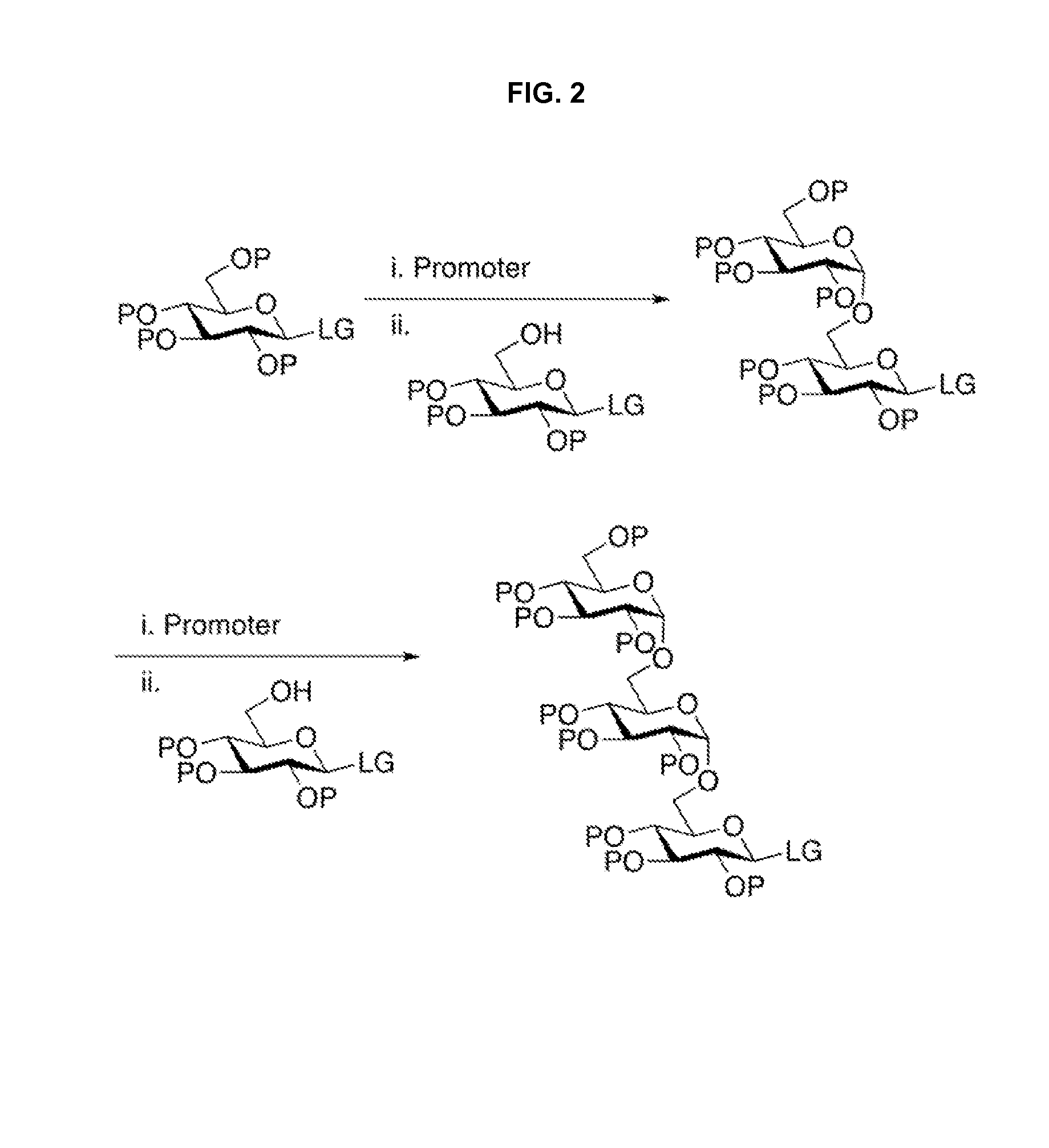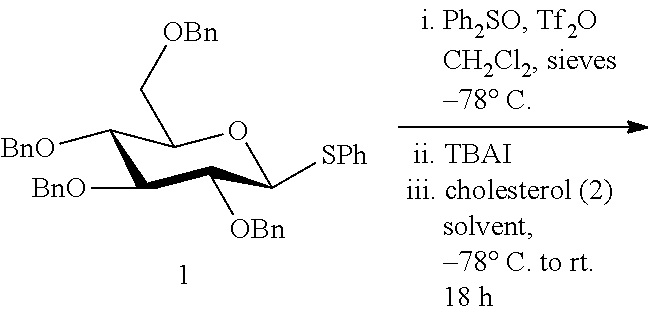Stereoselective Glycosylation Reactions
- Summary
- Abstract
- Description
- Claims
- Application Information
AI Technical Summary
Benefits of technology
Problems solved by technology
Method used
Image
Examples
example 1
[0053]
Cholesteryl-O-2,3,4,6-tetra-O-benzyl-α-D-glucopyranose (3)
[0054]A solution of donor 1a (1.0 equiv., 0.075 mmol, 47.5 mg), Ph2SO (2.8 equiv., 0.210 mmol, 42.5 mg), TTBP (3.0 equiv., 0.225 mmol, 55.9 mg), N-methylmaleimide (1.5 equiv., 0.113 mmol, 12.5 mg) and freshly activated 4 Å molecular sieves (100 mg) in dry dichloromethane (1.00 mL) was cooled to −78° C. and then treated drop-wise with trifluoromethanesulfonic anhydride (Tf2O, 1.4 equiv., 0.106 mmol, 18 μL). After stirring at low temperature for 5 min, a solution of tetrabutylammonium iodide (TBAI, 5 equiv., 0.375 mmol, 138.0 mg) in dichloromethane (0.75 mL) was added to the reaction. Stirring was continued for an additional 10 min at −78° C., after which time the reaction mixture was treated with a solution of acceptor 2 (2.0 equiv., 0.150 mmol, 43.5 mg) in 1:1 dichloromethane / dioxane (0.50 mL / 0.50 mL). The reaction mixture was then allowed to slowly warm up to room temperature and stirred for 18 h. The reaction was then...
example 2
[0056]
Methyl O-(2,3,4,6,-tetra-O-benzyl-α-D-glucopyranosyl)-(1->6)-2,3,4-tri-O-benzyl-α-D-glucopyranoside (5)
[0057]A solution of donor 1a (1.0 equiv., 0.075 mmol, 47.5 mg), Ph2SO (2.8 equiv., 0.210 mmol, 42.5 mg), TTBP (3.0 equiv., 0.225 mmol, 55.9 mg), N-methylmaleimide (1.5 equiv., 0.113 mmol, 12.5 mg) and freshly activated 4 Å molecular sieves (100 mg) in dry dichloromethane (1.00 mL) was cooled to −78° C. and then treated drop-wise with trifluoromethanesulfonic anhydride (Tf2O, 1.4 equiv., 0.106 mmol, 18 μL). After stirring at low temperature for 5 min, a solution of tetrabutylammonium iodide (TBAI, 5 equiv., 0.375 mmol, 138.0 mg) in dichloromethane (0.75 mL) was added to the reaction. Stirring was continued for an additional 10 min at −78° C., after which the reaction mixture was treated with a solution of acceptor 4 (2.0 equiv., 0.150 mmol, 69.6 mg) in 1:1 dichloromethane / dioxane (0.50 mL / 0.50 mL). The reaction mixture was then allowed to slowly warm up to room temperature and...
example 3
[0059]
Cholesteryl-O-2,3,4,6-tetra-O-benzyl-α-D-galactopyranose (12)
[0060]A solution of donor 1b (1.0 equiv., 0.075 mmol, 47.5 mg), Ph2SO (2.8 equiv., 0.210 mmol, 42.5 mg), TTBP (3.0 equiv., 0.225 mmol, 55.9 mg), N-methylmaleimide (1.5 equiv., 0.113 mmol, 12.5 mg) and freshly activated 4 Å molecular sieves (100 mg) in dry dichloromethane (1.00 mL) was cooled to −78° C. and then treated drop-wise with trifluoromethanesulfonic anhydride (Tf2O, 1.4 equiv., 0.106 mmol, 18 μL). After stirring at low temperature for 5 min, a solution of tetrabutylammonium iodide (TBAI, 5 equiv., 0.375 mmol, 138.0 mg) in dichloromethane (0.75 mL) was added to the reaction. Stirring was continued for an additional 10 min at −78° C., after which the reaction mixture was treated with a solution of acceptor 2 (2.0 equiv., 0.150 mmol, 43.5 mg) in 1:1 dichloromethane / dioxane (0.50 mL / 0.50 mL). The reaction mixture was then allowed to slowly warm up to room temperature and stirred for 18 h. The reaction was then f...
PUM
| Property | Measurement | Unit |
|---|---|---|
| Temperature | aaaaa | aaaaa |
| Lattice constant | aaaaa | aaaaa |
| Fraction | aaaaa | aaaaa |
Abstract
Description
Claims
Application Information
 Login to View More
Login to View More - R&D
- Intellectual Property
- Life Sciences
- Materials
- Tech Scout
- Unparalleled Data Quality
- Higher Quality Content
- 60% Fewer Hallucinations
Browse by: Latest US Patents, China's latest patents, Technical Efficacy Thesaurus, Application Domain, Technology Topic, Popular Technical Reports.
© 2025 PatSnap. All rights reserved.Legal|Privacy policy|Modern Slavery Act Transparency Statement|Sitemap|About US| Contact US: help@patsnap.com



